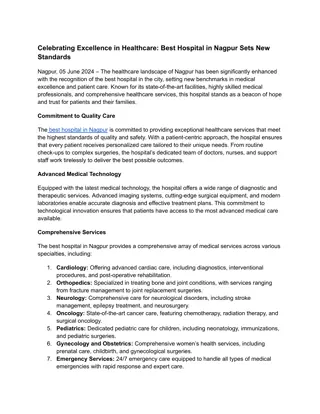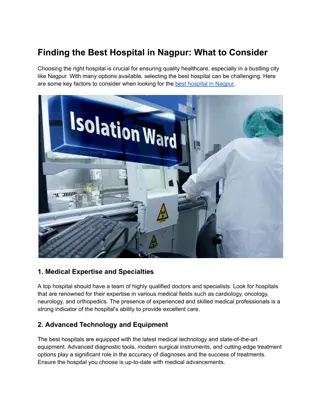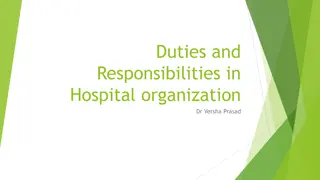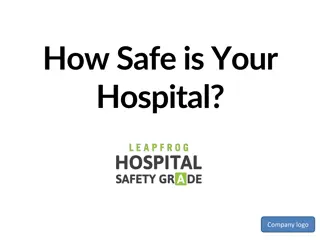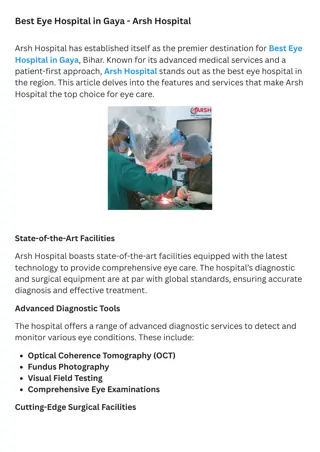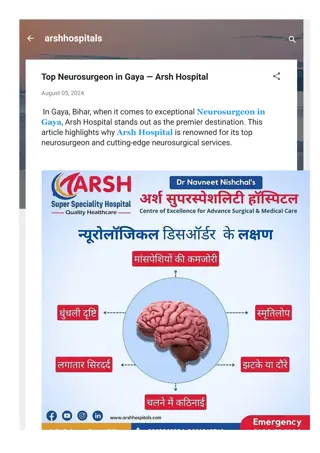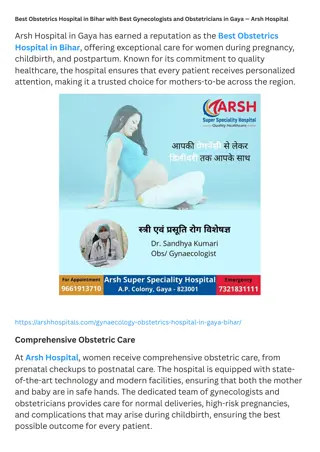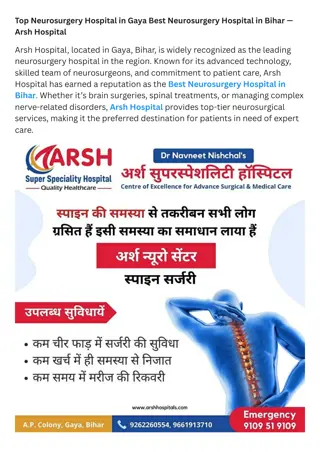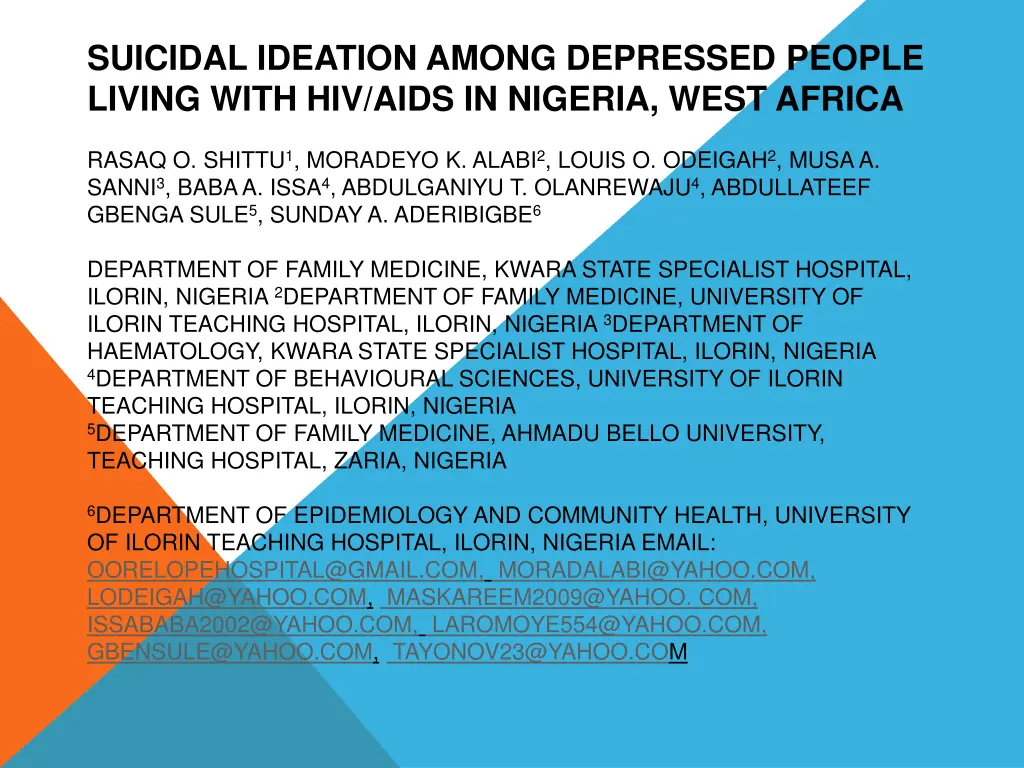
Suicidal Ideation Among People with HIV/AIDS in Nigeria
Explore the relationship between hopelessness, depression, and suicidal ideation among people living with HIV/AIDS in Nigeria. The study aims to understand the prevalence and factors contributing to suicidal behavior in this population.
Download Presentation

Please find below an Image/Link to download the presentation.
The content on the website is provided AS IS for your information and personal use only. It may not be sold, licensed, or shared on other websites without obtaining consent from the author. If you encounter any issues during the download, it is possible that the publisher has removed the file from their server.
You are allowed to download the files provided on this website for personal or commercial use, subject to the condition that they are used lawfully. All files are the property of their respective owners.
The content on the website is provided AS IS for your information and personal use only. It may not be sold, licensed, or shared on other websites without obtaining consent from the author.
E N D
Presentation Transcript
SUICIDAL IDEATION AMONG DEPRESSED PEOPLE LIVING WITH HIV/AIDS IN NIGERIA, WEST AFRICA RASAQ O. SHITTU1, MORADEYO K. ALABI2, LOUIS O. ODEIGAH2, MUSA A. SANNI3, BABA A. ISSA4, ABDULGANIYU T. OLANREWAJU4, ABDULLATEEF GBENGA SULE5, SUNDAY A. ADERIBIGBE6 DEPARTMENT OF FAMILY MEDICINE, KWARA STATE SPECIALIST HOSPITAL, ILORIN, NIGERIA 2DEPARTMENT OF FAMILY MEDICINE, UNIVERSITY OF ILORIN TEACHING HOSPITAL, ILORIN, NIGERIA 3DEPARTMENT OF HAEMATOLOGY, KWARA STATE SPECIALIST HOSPITAL, ILORIN, NIGERIA 4DEPARTMENT OF BEHAVIOURAL SCIENCES, UNIVERSITY OF ILORIN TEACHING HOSPITAL, ILORIN, NIGERIA 5DEPARTMENT OF FAMILY MEDICINE, AHMADU BELLO UNIVERSITY, TEACHING HOSPITAL, ZARIA, NIGERIA 6DEPARTMENT OF EPIDEMIOLOGY AND COMMUNITY HEALTH, UNIVERSITY OF ILORIN TEACHING HOSPITAL, ILORIN, NIGERIA EMAIL: OORELOPEHOSPITAL@GMAIL.COM, MORADALABI@YAHOO.COM, LODEIGAH@YAHOO.COM, MASKAREEM2009@YAHOO. COM, ISSABABA2002@YAHOO.COM, LAROMOYE554@YAHOO.COM, GBENSULE@YAHOO.COM, TAYONOV23@YAHOO.COM
INTRODUCTION INTRODUCTION Suicidal ideation is thought about or an unusual preoccupation with suicide. The range of suicidal ideation varies greatly from fleeting to detailed planning, self-harm and unsuccessful attempts, which may be deliberately constructed to fail or be discovered, or may be fully intended to result in death. Although, most people who undergo suicidal ideation do not go on to make suicide attempts, a significant proportion do1. Suicidal ideation is more common that suicide attempts or completed suicide2. To assess patients for suicide risk, warning signs and assess for risk and protective factors are pertinent. The warning signs are, threatening to hurt or kill self, or looking for ways to kill self, hopelessness, increasing alcohol or drug abuse, withdrawal from friends, family or society. PROBLEM STATEMENT Globally, approximately one million people kill themselves every year3.The WHO estimates that, by the year 2020, the worldwide incidence of suicide will reach approximately 1.53 million people, and 10 and 20 times as many individuals will attempt suicide. This global projection indicates that, suicidal behaviours constitute a significant public health problem4. Besides, it has been established that depressive disorders, a major cause of suicides, hitherto thought to be rare in Africa, are now recognized to be fairly common. Studies in Africa have reported high rates of depressive symptoms and suicidal behaviour in HIV-infected patients. In Ife, Nigeria, rates were found to be 0.4 per 100,000 populations3.
PURPOSE OF THE STUDY While suicidal ideation had been extensively studied in the general population3 5, its relationship with HIV infection was less well documented. This is of concern, since the psychological responses to an HIV-positive result can be wide ranging and include feeling hopelessness, anxiety, worthlessness and depression and suicidal behaviour6 7. Recognizing this, in a bio-psychosocial context, is paramount to understanding the relationship between the HIV/AIDS pandemic and increased prevalence of suicidal behavior7. Research8, 9suggests that people who are HIV positive may be at greater risk for suicide than their uninfected counterparts. HIV/AIDS had been recognized as a predictor of suicidality10. Previous studies had identified social isolation, lack of social support and stressful live events as prominent risk factors and indications for suicidal behaviour in PLWAs. However, results from previous studies comparing the rates of suicidal thought and behavior among PLWAs had been conflicting and inconsistent. These studies were performed before the advent of free HAART, when the prognosis of People with HIV was much poorer. Furthermore, there is a paucity of data on the suicidal ideation among PLWHAs in Nigeria in general, and North central in particular. It is against this backdrop, that the present study aimed to explore the relationship between hopelessness, depression and suicidal ideation among PLWHAs.
METHODOLOGY METHODOLOGY This study was conducted at a designated HIV/AIDS treatment centre located in Ilorin, North Central Nigeria. This study was a descriptive, cross-sectional study carried out from 1stof April to 15thJuly, 2013. The sample size was estimated using the Fisher formular11, using 21.3% from a previous study12, as the best estimate of depressive disorders among PLWAs. A minimum size of 218 was calculated using Fisher s formula but 300 was used to increase the power and reliability of the study. Ethical approval was obtained from the Ethical Review Committee of the Kwara State Ministry of Health be-fore commencement of the study. An interviewer administered questionnaire was used. The prevalence of depressive disorders and suicidal assessment among HIV/AIDS patients were assessed using the PHQ-9 scale. The Patients Health Questionnaire (PHQ-9)13is a brief, 9-item, patients self-report depression assessment tool that was derived from the interview-based PRIME-MD14. It was specifically developed for use in primary care general medical settings. It is the only short self-report tool that can reasonably be used both for diagnosis of DSM-4 major depression as well as for tracking of severity of major depression over time15. Psychometric evaluation of the PHQ-9 revealed a sensitivity ranging from 62% - 92% and a specificity between 74% - 88%.
METHODOLOGY CONT Respondent also completed the social determinant of depression questionnaire to access the social cohesion16,17. Based on existing research16,17, we used three key SDH: socioeconomic status, social cohesion and negative life events. Socioeconomic status included two indicators: years of schooling and self -reported economic status of the family, in general, in the previous year. Categories for years of schooling were as follows: above average (7 years and above), average (1 - 6 years) and below average (0 years). Economic status of the family was self- reported as good, average or poor. Social cohesion was assessed from responses to two questions: (1) in the previous year, how often did you ask someone for help when you had problems? (Never = 1; Seldom = 2; Sometimes = 3; Often = 4), and when you had problems? (spouse or lover; parents, brothers, sisters or children; other relatives; people outside the family; organization or schools with whom you are affiliated; government, party or trade unions; religious or non-governmental organizations; other organizations) (no = 0; yes = 1). Negative life events were gauge using a 12-item scale (serious illness in oneself, serious illness in the family, financial difficulties, conflict with spouse, conflict with other family members, conflict with people in the village, conflict between family members, infertility issues, problems at work or school, problems in an intimate relationship, abuse and other events). Completed questionnaire and measurements were entered into a computer data base. The data were analyzed using the epidemiological information (Epi-info) 2005 software package. The 2 by 2 contingency tables were used to carry out Chi-square test and to find out the level of significance and values less than 0.05 were regarded as statistically significant.
RESULTS RESULTS TABLE TABLE 1 1. . SOCIO-DEMOGRAPHIC CHARACTERISTICS OF RESPONDENTS. Variable N = 170 (%) Age group (years) <26 26 - 30 31 - 35 19 27 20 11.2 15.9 11.8 Mean age is 39y with SD of 10.8 36 - 40 50 29.4 41 - 45 46 - 50 51 - 55 56 - 60 11 19 6 11 6.5 11.1 3.5 6.5 >60 7 4.1 Gender Male 31 18.2 Female 139 81.8 Ethnicity Hausa Yoruba Igbo 39 92 28 22.9 54.1 16.5 Others 11 6.5 Religion Christianity Islam 30 139 17.6 81.8 Traditional 1 0.6 Marital Status Single Married Separated/Divorced 14 14 116 8.2 8.2 68.3 Widowed/Widower 26 15.3 Educational level Non-Formal Primary Secondary 56 55 42 32.9 32.4 24.7 Tertiary 17 10.0 Occupation Trader Civil servant Self employed Unemployed 91 16 43 14 53.5 9.4 25.4 8.2 Students 6 3.5 Monthly Income No Income 20000 20001-30000 30001-40000 40001-50000 20 129 10 6 3 11.8 75.9 5.8 3.5 1.8 >50000 2 1.2
TABLE 1 CONT Table 1 shows the socio-demographic characteristics of the respondents. A total of one hundred and seventy sero-positive respondents with depression were recruited to the study. The age range 36 - 40 years, had the highest number of respondents 50 (29.4%) . Females 139 (81.8%), outnumbered males 31 (18.2%) giving a male: female ratio of 1:4.5. Predominantly, 139 (81.8%) were Muslims, why Christian constituted 30 (17.6%). One hundred and sixteen (68.3%) were separated/divorce while 26 (15.3), were widow/widower. The majority of them 56 (32.9%), had no formal education, Majority, 91 (53.5%), were traders, while 14 (8.2%), were unemployed. Six (3.5%) were students.
TABLE 2. TABLE 2. ASSOCIATION BETWEEN FEELING OF HOPELESS AND DEPRESSION depressed feeling hopeless total yes (%) no (%) p-value yes 29(17.1) 0(0.0) 29(9.7) 0.000 no 141 (82.9) 130(100.0) 271(90.3) total 170(100.0) 130(100.0) 300 (100.0) Table Table 2 2 displays the association between hopelessness and depression. Twenty nine (17.1%) were hopeless, while 141 (82.9%) were not. The association between feeling hopeless and depressed was statistically signifi-cant (p-value = 0.000).
TABLE 3. TABLE 3. ASSOCIATION BETWEEN THOUGHT OF TAKING LIFE AND DEPRESSION depressed thought of taking life total yes (%) no (%) p-value yes 28(16.5) 0(0.0) 28(9.3) 0.000 no 142 (83.5) 130(100.0) 272(90.7) total 170(100.0) 130(100.0) 300 (100.0) Table Table 3 3 shows the association between thought of taking one s life and depression. Twenty eight (16.5%) had at one time or the other thought of taking their life, while 142 (83.5%) did not. The association between thought of taking life and depression was statistically significant (p- value = 0.000).
TABLE 4. TABLE 4. ASSOCIATION BETWEEN PLAN TO TAKE LIFE AND DEPRESSION depressed plan to take life total yes (%) no (%) p-value yes 6(3.5) 0(0.0) 6(2.0) 0.030 no 164 (96.5) 130(100.0) 294 (98.0) total 170(100.0) 130(100.0) 300(100.0) Table Table 4 4 shows the association between plan to take life and depression. Six (3.5%) had plan to take their lives, while 164 (96.5%) were still optimistic. This is of statistical importance (p-value = 0.03).
TABLE TABLE 5 5. . ASSOCIATION BETWEEN SOCIAL COHESION AND DEPRESSION AMONG HIV PATIENTS AT KWARA STATE SPECIALIST HOSPITAL, SOBI, ILORIN Social Cohesion Low Fair High Total Depression p-value 0 - 2 3 - 5 6 - 9 (%) Depressed Male 21 (67.7) 8 (25.9) 2 (6.5) 31 (100) 0.005 Depressed Female 112 (80.6) 27 (19.4) 0 (0.0) 139 (100) Table Table 5 5 shows the association between social cohesion and depression among the respondents. The Social Cohesion was very low in both males and females, 21 (67.7%) and 112 (80.6%) respectively among the de- pressed HIV patients. Only 2 (6.5%) males had high social cohesion. This was statistically significant (p-value = 0.005).
TABLE TABLE 6 6. . ASSOCIATION BETWEEN NEGATIVE LIFE EVENTS AND DEPRESSION AMONG HIV PATIENTS AT KWARA STATE SPECIALIST HOSPITAL, SOBI, ILORIN. Negative Life Events Depression Depressed Male 0 1 2 3 - 9 Total p-value 0(0.0) 17 (54.8) 5 (16.1) 9 (29.1) 31 (100.0) 0.004 Depressed Female 32(23.0) 33 (23.7) 29 (20.9) 45 (32.3) 139 (100.0) Table Table 6 6 shows that negative life events was strongly associated with depression. Twenty-two (70.9%) males and 62 (44.6%) females had one or two negative live events whereas 9 (29.1%) males and 45 (32.3%) female s respondents had more than three negative life events. This was of statistical importance (p-value = 0.004).
DISCUSSION DISCUSSION One hundred and seventy (56.7%) satisfied the criteria for a depressive disorder using the PH-9 score. The findings in this study confirmed those of earlier studies18,19 that many HIV- positive patients have high levels of depressive symptomatology, as well as the fact that those with suicidal ideation reported increased levels of such symptoms. PHQ-9 questionnaire of depression was used to contextualize this relationship, because the cognitive symptoms of depression tend to precede the affective and mood components of the disorder, which in turn are triggered by negative automatic thoughts in suicidal behaviour. The association between feeling hopeless and depressed was statistically significant. Hopelessness is a primary mediator that links depression and suicidal ideation, and the more hopeless the individual feels about the future, the more depressed they are likely to become, unless appropriate interventions are implemented.
DISCUSSION DISCUSSION CONT Some of the HIV-positive patients in this study felt that the future was blink, irrespective of whether or not they had suicidal ideation, hence this can be yardsticks that can be used by less highly trained health professionals for screening purposes at VCT clinics, and thus be used in treatment strategies to help prevent suicidal behaviour in these patients. The value obtained for patients with suicidal thought, hopelessness and plan to take life is comparable to the study of Haller and colleagues20,21 while studying suicidal ideation among psychiatric morbidity. The association between thought of taking life and depression was statistically significant. April and colleagues22reported that 79% of participants reported no thoughts of suicide. 20% reported suicidal thoughts but no intent to commit suicide, and less that 2% reported a current suicide attempt22. Similarly, in the study conducted at the specialty HIV clinic at a tertiary care center of South India, 20% expressed suicidal ideation, and 6% reported persistent suicidal ideations, whereas 8% had made attempts to commit suicide23. In Spain, Carvajai and colleagues24 assessed 442 HIV-infected patients for suicidality, 5 patients had suicidal thought, 5 had suicidal equivalents, and 17 suicidal attempts of a total of 27 cases. 2 died as a result of suicide24. CONT
DISCUSSION DISCUSSION CONT Gregory and co-workers25 found out that 53% thought about killing themselves and almost one-quarter either often (15%), or very often (7%) thought about killing themselves. A substantial proportion reported to have actually attempted to kill themselves (36%). These values were much higher than our study. Six (3.5%), had plan to take their lives, while 164 (96.5%), were still optimistic. This is of statistical importance (p-value = 0.03). In Nigeria, Chikezie and colleagues10 while studying suicidality among PLWAs in Benin City found out that (34.7%) expressed suicidal ideation, while 9.3% attempted suicide. Similar to this study, the commonest type of attempt was the use of pesticides and anti-malaria overdose. CONT (80.6%) respectively among the depressed HIV patients. Only 2 (6.5%) males had high social cohesion. This was statistically significant. This was similar to the findings of Starace26 in his study, suicidal behaviours, enthanasia and AIDS where he concluded that PLWAs who attempted suicide were more likely to experience social isolation and lack social support. Twenty-two (70.9%) males and 62 (44.6%) females had one or two negative live events whereas 9 (29.1%) males and 45 (32.3%) females respondents had more than three negative life events. This is of statistic-al importance. A positive HIV diagnosis may be viewed by some as a negative life event resulting in, among others, marital problems, financial problems, stigmatization by family, friends and community, fear of disclosure of a positive HIV test result, problems in accessing health care, and other difficulties1 The majority of the HIV-positive patients in this study felt that the future seemed dark to them, irrespective of whether or not they had suicidal ideation. Social Cohesion was very low in both males and females, 21 (67.7%) and 112
LIMITATION There are few limitations of the study that may reduce the generalization of our findings. The relatively small sample may be a potential limitation, but its calculation, estimated this number as sufficient to detect depression rates difference between asymptomatic and symptomatic HIV/AIDS patients. Furthermore like all cross-sectional studies, it is difficult to establish causal association between dependent and independent variables. RECOMMENDATION RECOMMENDATION During the initial evaluation of the new patients, the physician should ask about a history of psychiatric disorders. The patient should be asked about history of suicidal ideation and suicide attempts. Similarly, all new patients should be screened for alcohol abuse using the CAGE questionnaire27. Any patient who shows evidence of depressed mood, anxiety of substance abuse should be asked about recent stressors and suicidal ideation and undergo a full evaluation for the presence of depression.
REFERENCES REFERENCES Mayou, R. (1984) Oxford Text , R. (1984) Oxford Text- -Book of Psychiatry. 2nd Edition, American Psychiatry Association, 478 Book of Psychiatry. 2nd Edition, American Psychiatry Association, 478- -506. 1. 1. Gelder Gelder, M., Gath, D. and , M., Gath, D. and Mayou 506. 2 2. . Marzuk Marzuk, P.M. (1991) Suicidal , P.M. (1991) Suicidal Behaviour http://dx.doi.org/10.3109/0954026910907214 http://dx.doi.org/10.3109/09540269109072143 3 Behaviour and HIV Illnesses. and HIV Illnesses. International Review of Psychiatry International Review of Psychiatry, 3, 365 , 3, 365- -371. 371. 3 3. . Murad Murad, M.K. (2005) Suicide Prevention and Developing Countries. , M.K. (2005) Suicide Prevention and Developing Countries. Journal of the Royal Society of Medicine http://dx.doi.org/10.1258/jrsm.98.10.45 http://dx.doi.org/10.1258/jrsm.98.10.459 9 Journal of the Royal Society of Medicine, 98, 459 , 98, 459- -463. 463. 4. 4. Carolina, M.S., Jose, M.B. and Yuan, P.W. (2005) Epidemiology of Suicide in Brazil. Characterization of Age and Gender Rates Carolina, M.S., Jose, M.B. and Yuan, P.W. (2005) Epidemiology of Suicide in Brazil. Characterization of Age and Gender Rates of Suicide. Suicide. Revista Revista Brasileira Brasileira de de Psiquiatria Psiquiatria, 27, 1 , 27, 1- -8. 8. of 5 5. . Cooper Cooper- -Patrick, L., Crum, R.M. and Ford, D.E. (1994) Identifying Suicidal Ideation in General Medical Patients. Patrick, L., Crum, R.M. and Ford, D.E. (1994) Identifying Suicidal Ideation in General Medical Patients. JAMA 1762. 1762.http://dx.doi.org/10.1001/jama.1994.0352022005103 http://dx.doi.org/10.1001/jama.1994.03520220051030 0 JAMA, ,272, 1757 272, 1757- - 6. 6. Perry, S.W. (1994) HIV Perry, S.W. (1994) HIV- -Related Depression. Related Depression. Res Res Publ Publ Assoc Assoc Res Res Nerv Nerv Ment Ment Dis Dis, 72, 223 , 72, 223- -228 228 7. 7. Schlebusch Schlebusch, L. (2005) Suicidal , L. (2005) Suicidal Behaviour Behaviour in South Africa. University of Kwazulu in South Africa. University of Kwazulu- -Natal Press, Pietermaritzburg. Natal Press, Pietermaritzburg. 8. 8. Marzuk Marzuk, P.M., Journal of Psychiatry Journal of Psychiatry, 154, 1720 , P.M., Tardiff Tardiff, K. and Leon, A. (1997) HIV , K. and Leon, A. (1997) HIV Sero , 154, 1720- -1725. 1725. Sero- -Prevalence among Suicide Victims in New York City. 1991 Prevalence among Suicide Victims in New York City. 1991- -1993. 1993. American American 9 9. . McKgney McKgney, F.P. and O Dowd, M.A. (1992) , F.P. and O Dowd, M.A. (1992) Suicidality Suicidality and HIV Status. and HIV Status. American Journal of Psychiatry American Journal of Psychiatry, 149, 396 , 149, 396- -398. 398. 10 10. . Chikezie Chikezie, U.E., Nigeria: A Case Nigeria: A Case- -Control Study. , U.E., Otakpor Otakpor, A.N., Control Study. AIDS Care , A.N., Kuteyi Kuteyi, O.B. and James, B.O. (2012) , O.B. and James, B.O. (2012) Suicidality AIDS Care, 24, 843 , 24, 843- -845. 845. http://dx.doi.org/10.1080/09540121.2011.64500 http://dx.doi.org/10.1080/09540121.2011.645008 8 Suicidality among Individuals with HIV/AIDS in Benin City, among Individuals with HIV/AIDS in Benin City, 11 11. . Araoye Araoye, M.O. (2003) Data Collection. In: , M.O. (2003) Data Collection. In: Research Methodology with Statistics for Health and Social Sciences Research Methodology with Statistics for Health and Social Sciences, , Nathadex Publishers, Ilorin, 130 Publishers, Ilorin, 130- -159. 159. Nathadex 12 12. . Ndu Ndu, A.C., , A.C., Arinze A Study of Adult HIV/AIDS Patients Attending HIV/AIDS Clinic in a Tertiary Health Facility in South A Study of Adult HIV/AIDS Patients Attending HIV/AIDS Clinic in a Tertiary Health Facility in South- -Eastern Nigeria. Health and Epidemiology Health and Epidemiology, 3, 182 , 3, 182- -186. 186. Arinze, S.U., , S.U., Aguwa Aguwa, E.N. and , E.N. and Obio Obio, I.E. (2011) Prevalence of Depression and Role of Support Group in Its Management: , I.E. (2011) Prevalence of Depression and Role of Support Group in Its Management: Eastern Nigeria. Journal of Public Journal of Public 13 13. . Kapla Kapla, A. and , A. and Saddock Saddock, B.J. (2003) Synopsis of Psychiatry. 9th Edition, Lippincott Williams and , B.J. (2003) Synopsis of Psychiatry. 9th Edition, Lippincott Williams and Willkins Willkins, , Philadephia Philadephia, , 14 14. . Sharp, L.K. and Sharp, L.K. and Lipsky Settings. Settings. American Family Physician American Family Physician, 66, 1001 Lipsky, M.S. (2002) Screening for Depression across the Life Span: A Review of Measures for Use in Primary Care , M.S. (2002) Screening for Depression across the Life Span: A Review of Measures for Use in Primary Care , 66, 1001- -1008. 1008. 15 15. . Liang, Y., Gong, T.H., Gong, Y.H., Wen, X.P., Guan, C.P., Li, M.C., Yin, P. and Wang, Z.Q. (2012) Social Liang, Y., Gong, T.H., Gong, Y.H., Wen, X.P., Guan, C.P., Li, M.C., Yin, P. and Wang, Z.Q. (2012) Social Determi Depression: A Preliminary Investigation from Rural China. Depression: A Preliminary Investigation from Rural China. PLoS Determi- -nants nants of Health and of Health and PLoS ONE ONE, 7, Article ID: e30553. , 7, Article ID: e30553.
REFERENCES CONT. 16 16. . Word Word Health Health Organization Determinants Determinants of of Health Organization (WHO) Health. . http (WHO) ( (2008 http: ://www //www. .searo 2008) ) A A Closing searo. .who Closing the who. .int/LinkFiles/SDH_SDH_FinalReport int/LinkFiles/SDH_SDH_FinalReport. .pd the Gap Gap in in a a Generation Generation: : Health Health Equity Equity through through Action pdf f Action of of on on the the Social Social 17 17. . Stewart, Stewart, D D. .E E. . ( (2007 2007) ) Social Social Determinants Determinants of of Women s Women s Mental Mental Health Health. . Journal Journal of of Psychosomatic Psychosomatic Research Research, , 63 63, , 223 223- - http http: ://dx //dx. .doi doi. .org/ org/10 10. .1016 1016/j /j. .jpsychores jpsychores. .2007 2007. .07 07. .00 002 2 18 18. . Pence, Pence, B B. ., , Reil Abuse Abuse. . HIV Reil, , S S. ., , Whetten HIV- -Infected Infected Patients Whetten, , K K. ., , Leserman Patients in in the the US Leserman, , J J. ., , Stangl US. . Deep Deep South Stangl, , D D. ., , Swartz, South. . Southern Southern Medical Swartz, M M. ., , et et al al. . ( (2007 Medical Journal Journal, , 100 2007) ) Minorities, Minorities, the 100, , 1114 1114- -1122 the Poor Poor and 1122. . and Survivors Survivors of of 19 19. . Asch, Asch, S S. .M M. ., , Kibourne Consortium Consortium ( (2003 http http: ://dx //dx. .doi Kibourne, , A A. .M M. ., , Gifford, 2003) ) Under Under Diagnosis doi. .org/ org/10 10. .1046 1046/j /j. .1525 Gifford, A A. .L L. ., , Burnam Diagnosis of of Depression 1525- -1497 1497. .2003 2003. .20938 Burnam, , M M. .A A. ., , Turner, Depression in in HIV 20938. .x x Turner, B B. ., , Shapiro, HIV. . Journal Journal of of General Shapiro, M M. .F F. . and General Internal and Bozzette Bozzette, , S S. .A A. . for Internal Medicine Medicine, , 18 for the 18, , 450 the HCSUS HCSUS 450- -460 460. . 20 20. . Beck, Beck, A A. .T T. ., , Steer, Study Study of of Patients Steer, R R. .A A. ., , Kovacs, Patients Hospitalized Hospitalized with Kovacs, M M. . and with Suicidal and Garrison, Garrison, B B. . ( (1985 Suicidal Ideation Ideation. . American 1985) ) Hopelessness Hopelessness and American Journal Journal of of Psychiatry and Eventual Eventual Suicide Psychiatry, , 142 142, , 559 Suicide: : A A 10 559- -563 563. . 10- -Years Years Prospective Prospective 21 21. . Haller, Haller, D D. .L L. . and of of Life Life. . AIDS and Miles, Miles, D D. .R R. . ( (2003 AIDS and and Behavior Behavior, , 7 7, , 101 2003) ) Suicidal Suicidal Ideation 101- -108 108. . http http: ://dx Ideation among //dx. .doi doi. .org/ among Psychiatric Psychiatric Patient org/10 10. .1023 1023/A Patient with /A: :102398590616 1023985906166 6 with HIV HIV: : Psychiatric Psychiatric Morbidity Morbidity and and Quality Quality 22 22. . April, April, C C. . and and Courtney, Courtney, M M. . ( (2011 2011) ) Depression Depression Is Is Common Common in in People People with with HIV HIV AIDS AIDS. . The The AIDS AIDS Beacons Beacons, , 7 7, , 1 1- -3 3. . 23 23. . Chandre Chandre, , P P. .S S. ., , Ravi, mosexuals mosexuals. . A A Report 3999 3999( (98 98) )00028 Ravi, V V. ., , Desai, Report from from India 00028- -2 2 Desai, A A. . and India. . Journal and Subbakrishna Subbakrishna, , D D. .K K. . ( (1998 Journal of of Psychosomatic Psychosomatic Research 1998) ) Anxiety Research, , 45 Anxiety and 45, , 401 401- -409 and Depression Depression among 409. . http http: ://dx among HIV //dx. .doi doi. .org/ HIV- -Infected Infected Ho org/10 10. .1016 1016/S Ho- - /S0022 0022- - 24 24. . Carvajai Carvajai, , N N. .J J. ., , Vicioso http http: ://dx //dx. .doi Vicioso, , C C. ., , Santamaria Santamaria, , J J. .M M. . and doi. .org/ org/10 10. .1080 1080/ /0954012955012612 09540129550126128 8 and Bosco Bosco, , A A. . ( (1995 1995) ) AIDS AIDS and and Suicide Suicide Issues Issues in in Spain Spain. . AIDS AIDS Care Care, , 7 7, , 135 135- -138 138. . 25 25. . Gregory, Gregory, A A. ., , Amenla Suicidal Suicidal Ideation 244 244X X- -13 13- -15 Amenla, , N N. ., , Luke, Ideation among among Men 151 1 Luke, S S. ., , Shalini Men Who Who Inject Shalini, , S S. ., , Anthony, Inject Drug Drug in in Delhi, Anthony, F F. .J J. . and Delhi, India and Michelle, Michelle, K K. . ( (2013 India. . BMC BMC Psychiatry Psychiatry, , 13 2013) ) Quality Quality of of Life, 13, , 151 151. . http Life, Depression, Depression, An http: ://dx //dx. .doi doi. .org/ An- -xiety xiety and 10. .1186 1186/ /1471 and 1471- - org/10 25 25. . Flaving Flaving, , D D. .K K. ., , Franklin, Behaviour Behaviour in in Alcohol Franklin, J J. .E E. . and Alcohol- -Dependent Dependent Homosexual and Frances, Frances, R R. .J J. . ( (1986 Homosexual Men 1986) ) The Men. . American American Journal The Acquired Acquired Immune Journal of of Psychiatry Immune Deficiency Deficiency Syndrome Psychiatry, , 143 143, , 1440 Syndrome (AIDS) 1440- -1442 1442. . (AIDS) and and Sui Sui- -cidal cidal 26 26. . Starace Starace, , http http: ://dx F F. . doi. .org/ org/10 and and 10. .1097 1097/ /00002030 Sherr Sherr, , L L. . ( (1998 1998) ) 199804000- -0000 Suicidal Suicidal Behaviour Behaviour, , 00001 1 Euthanasia, Euthanasia, and and AIDS AIDS. . AIDS AIDS, , 12 12, , 339 339- -347 347. . //dx. .doi 00002030- -199804000




